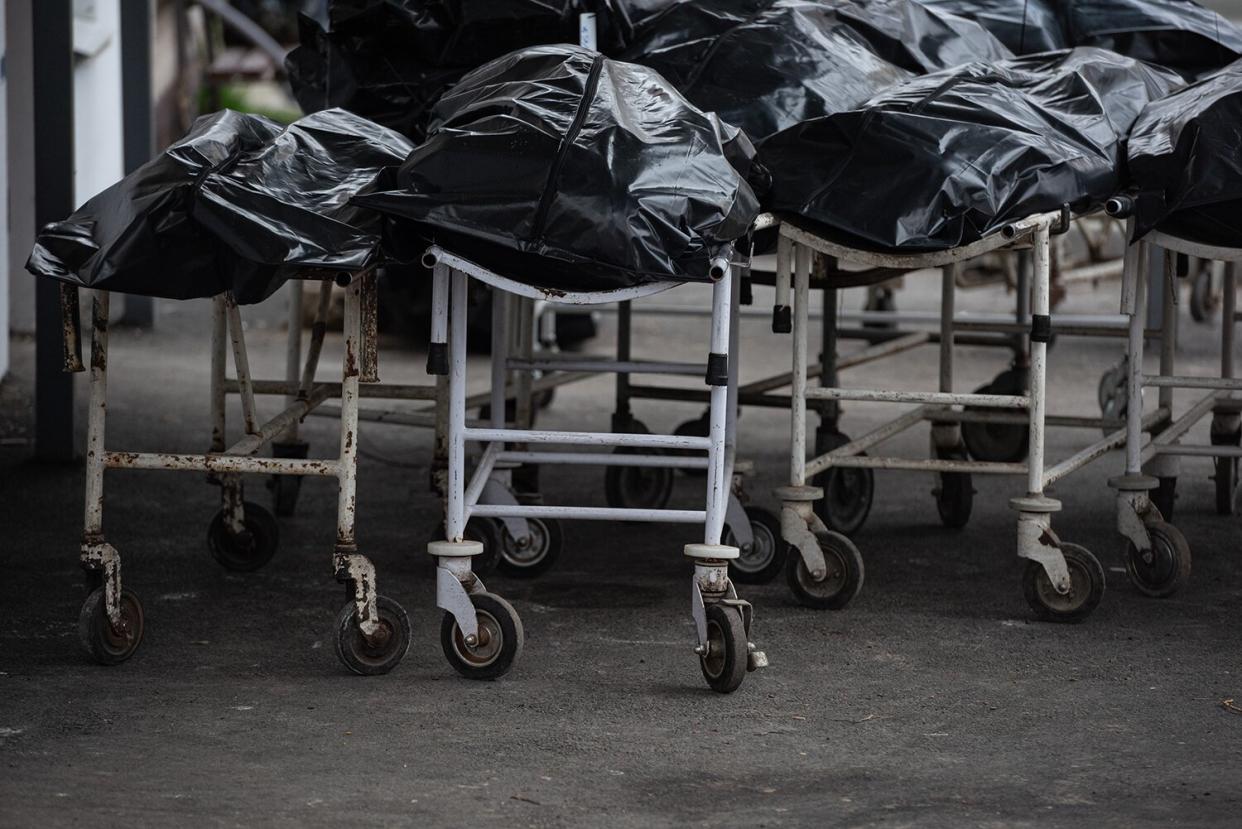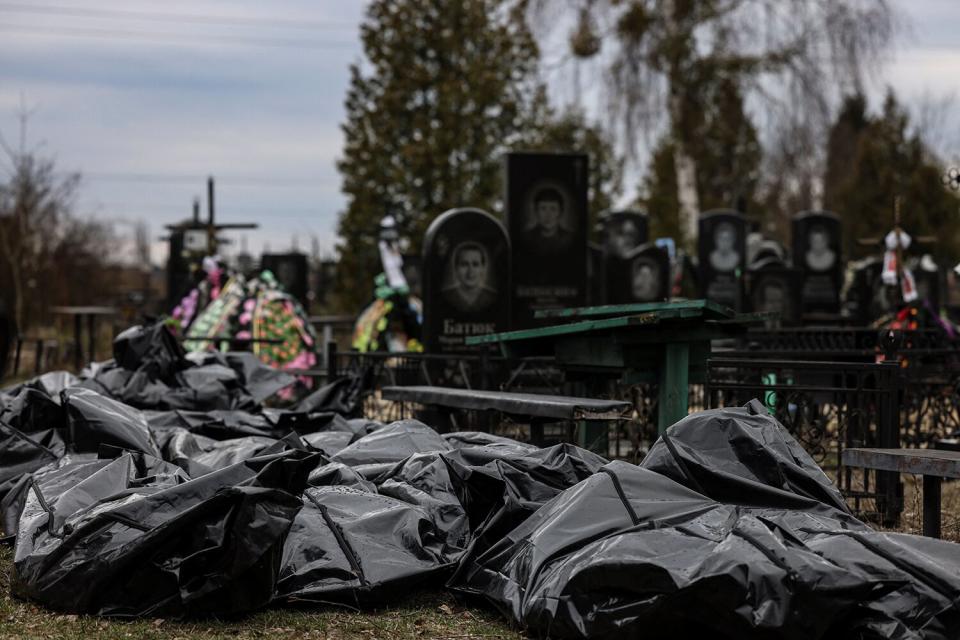Ukrainian Coroner Describes Horror of Performing 10 Autopsies a Day on Mangled Bodies: 'Why Did You Die?'

Alexey Furman/Getty
Not long after Russia invaded Ukraine, Vlad Perovskyi saw some of the war's first victims: soldiers killed in combat.
By mid-March, bodies in civilian clothes began to arrive at the morgue inside Kyiv Regional Clinical Hospital, in the capital, where he works as a coroner in the forensic department. Weeks later, Perovskyi said he and his team are struggling to keep up with the number of dead arriving each day.
"These morgues were not designed to handle this amount of bodies," Perovskyi, 27, told The Washington Post in an interview published Wednesday.
Since the war began Feb. 24, per the Post, Perovskyi and five others have processed more than 200 bodies — sometimes performing up to 10 autopsies a day in a small room where only one of several windows is kept open just a crack to prevent more flies from coming in, though dozens are already stuck to a sticky trap that hangs from the ceiling.
RELATED: Ukraine's President Zelenskyy Expresses His Anguish Knowing Parents Have Lost Kids in Russia's War
Outside refrigerated trailers hold the dead, stacked three-high in rows. Once one is placed on his metal table, Perovskyi asks, "Why did you die?" before getting to work as one of more than 50,000 people investigating Russian forces' possible war crimes for Ukraine's Office of the Prosecutor General, the Post reports.
"I'm used to seeing horrible things done to bodies," Perovskyi told the paper. "But I was very shocked to see such horrible treatment of the deceased by the Russians. How can someone shoot a person and then run over the body? Or throw them into ditches. How can someone put a bullet into a dead man's head?"
RELATED VIDEO: Little Girl In Ukraine Performs 'Let It Go' At Bomb Shelter
Bruises on the face or stomach indicate the deceased could have been punched or kicked. Black and blue wrists might mean hands were tied behind the back. Frequently bodies arrive without heads, the Post reports. Many are filled with bullet fragments or pieces of twisted shrapnel lodged in the neck or torso. Some left for weeks in the rain or removed from shallow graves can't be cleaned because the decomposing flesh will fall apart.
"People think you get used to that smell," said Perovskyi, who burns church incense to cover it up. "We never do."
RELATED: The Ukrainian 'Genocide': Why a Country Officially Using That Word Matters
Like the stench, the reality of what's happening in Ukraine is impossible for Perovskyi and his colleagues to ignore. But he told the Post he's cut back on watching and reading about the war.
"The news put the bodies that I worked with into context," he said, "and that is what can mess me up."

RONALDO SCHEMIDT/AFP via Getty
He's also asked friends for therapist recommendations but he's not ready to explore the toll the war and his work is taking.
"I am actually a very sensitive and emotional person, despite my profession," Perovskyi said. "If I watch a movie and there is an emotional moment, that can bring me to tears."
Pavlo Snisarevskij, head of the hospital's anatomical pathology department and a colleague of Perovskyi said the team tries to focus on their work.
"What is the choice?" Snisarevskij asked. "When 56 bodies are brought in, the next day 20 bodies, 27 bodies — well, it lingers in memory. As you examine the body, you do not perceive it as a dead person. It is the object of study. But later, it catches up."
RELATED: Nurse Recalls Attack on Maternity Ward in Ukraine: 'Everything Turned White … in One Second'
One body that Perovskyi still thinks about belonged to a woman who was shot in the face through a windshield. Her car was then run over by a Russian armored vehicle, according to the Post. The woman was left inside, her body smashed and what was left of her head ripped off her body, which arrived at the morgue without any information that might have revealed her identity.
Perovskyi doesn't know her name. "All I know is that she came from Irpin," he said. "She was trying to evacuate."
Spending six hours examining a body, investigating the cause of death, is not an option these days but Perovskyi won't cut corners when it comes to handling the victims on his table. "Every single body I treat with respect," he said. "You have to do it."
At night, Perovskyi volunteers as a military medic in Kyiv, wrapping green tape around his arm to signify his military affiliation during the shift, before returning home to sleep on a military cot in his parents' two-bedroom apartment before returning to work at the morgue in the morning.
"Compared to guys in the army that are at the front lines," he said, "this is the least I can do."

Evgeniy Maloletka/AP/Shutterstock Dead bodies are put into a mass grave on the outskirts of Mariupol, Ukraine, as people cannot bury their dead because of the heavy shelling by Russian forces amid the invasion.
Russia's attack on Ukraine continues after their forces launched a large-scale invasion on Feb. 24 — the first major land conflict in Europe in decades.
Details of the fighting change by the day, but thousands of civilians have already been reported dead or wounded, including children, though the actual number of deaths is difficult to determine.
More than 5 million have fled the country as refugees — and half are children, according to the United Nations. Millions more have been displaced inside Ukraine.
The invasion, ordered by Russian President Vladimir Putin, has drawn condemnation around the world and increasingly severe economic sanctions against Russia.
RELATED: How Children Are Coping in the Aftermath of Russia's Brutal Occupation of One Ukrainian City
With NATO forces amassed in the region, various countries are offering aid or military support to the resistance. Ukraine's President Volodymyr Zelenskyy has called for peace talks — so far unsuccessful — while urging his country to fight back.
Putin insists Ukraine has historic ties to Russia and he is acting in the best security interests of his country. Zelenskyy vowed not to bend.
"Nobody is going to break us, we're strong, we're Ukrainians," he told the European Union in a speech in the early days of the fighting, adding, "Life will win over death. And light will win over darkness."
The Russian attack on Ukraine is an evolving story, with information changing quickly. Follow PEOPLE's complete coverage of the war here, including stories from citizens on the ground and ways to help.

